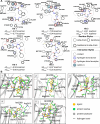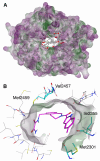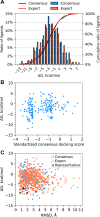In silico screening of LRRK2 WDR domain inhibitors using deep docking and free energy simulations
- PMID: 38873063
- PMCID: PMC11168082
- DOI: 10.1039/d3sc06880c
In silico screening of LRRK2 WDR domain inhibitors using deep docking and free energy simulations
Abstract
The Critical Assessment of Computational Hit-Finding Experiments (CACHE) Challenge series is focused on identifying small molecule inhibitors of protein targets using computational methods. Each challenge contains two phases, hit-finding and follow-up optimization, each of which is followed by experimental validation of the computational predictions. For the CACHE Challenge #1, the Leucine-Rich Repeat Kinase 2 (LRRK2) WD40 Repeat (WDR) domain was selected as the target for in silico hit-finding and optimization. Mutations in LRRK2 are the most common genetic cause of the familial form of Parkinson's disease. The LRRK2 WDR domain is an understudied drug target with no known molecular inhibitors. Herein we detail the first phase of our winning submission to the CACHE Challenge #1. We developed a framework for the high-throughput structure-based virtual screening of a chemically diverse small molecule space. Hit identification was performed using the large-scale Deep Docking (DD) protocol followed by absolute binding free energy (ABFE) simulations. ABFEs were computed using an automated molecular dynamics (MD)-based thermodynamic integration (TI) approach. 4.1 billion ligands from Enamine REAL were screened with DD followed by ABFEs computed by MD TI for 793 ligands. 76 ligands were prioritized for experimental validation, with 59 compounds successfully synthesized and 5 compounds identified as hits, yielding a 8.5% hit rate. Our results demonstrate the efficacy of the combined DD and ABFE approaches for hit identification for a target with no previously known hits. This approach is widely applicable for the efficient screening of ultra-large chemical libraries as well as rigorous protein-ligand binding affinity estimation leveraging modern computational resources.
This journal is © The Royal Society of Chemistry.
Conflict of interest statement
There are no conflicts to declare.
Figures






Similar articles
-
Active Learning-Guided Hit Optimization for the Leucine-Rich Repeat Kinase 2 WDR Domain Based on In Silico Ligand-Binding Affinities.J Chem Inf Model. 2025 Jun 9;65(11):5706-5717. doi: 10.1021/acs.jcim.5c00588. Epub 2025 May 25. J Chem Inf Model. 2025. PMID: 40415386 Free PMC article.
-
Functionally active modulators targeting the LRRK2 WD40 repeat domain identified by FRASE-bot in CACHE Challenge #1.Chem Sci. 2025 Jan 9;16(8):3430-3439. doi: 10.1039/d4sc07532c. eCollection 2025 Feb 19. Chem Sci. 2025. PMID: 39877816 Free PMC article.
-
CACHE Challenge #1: Targeting the WDR Domain of LRRK2, A Parkinson's Disease Associated Protein.J Chem Inf Model. 2024 Nov 25;64(22):8521-8536. doi: 10.1021/acs.jcim.4c01267. Epub 2024 Nov 5. J Chem Inf Model. 2024. PMID: 39499532
-
Artificial intelligence-enabled virtual screening of ultra-large chemical libraries with deep docking.Nat Protoc. 2022 Mar;17(3):672-697. doi: 10.1038/s41596-021-00659-2. Epub 2022 Feb 4. Nat Protoc. 2022. PMID: 35121854 Review.
-
Perspectives on current approaches to virtual screening in drug discovery.Expert Opin Drug Discov. 2024 Oct;19(10):1173-1183. doi: 10.1080/17460441.2024.2390511. Epub 2024 Aug 12. Expert Opin Drug Discov. 2024. PMID: 39132881 Review.
Cited by
-
Discovery of Crystallizable Organic Semiconductors with Machine Learning.J Am Chem Soc. 2024 Aug 7;146(31):21583-21590. doi: 10.1021/jacs.4c05245. Epub 2024 Jul 25. J Am Chem Soc. 2024. PMID: 39051486 Free PMC article.
-
Automated On-the-Fly Optimization of Resource Allocation for Efficient Free Energy Simulations.J Chem Inf Model. 2025 May 26;65(10):4932-4951. doi: 10.1021/acs.jcim.4c02107. Epub 2025 May 6. J Chem Inf Model. 2025. PMID: 40328725 Free PMC article.
-
Active Learning-Guided Hit Optimization for the Leucine-Rich Repeat Kinase 2 WDR Domain Based on In Silico Ligand-Binding Affinities.J Chem Inf Model. 2025 Jun 9;65(11):5706-5717. doi: 10.1021/acs.jcim.5c00588. Epub 2025 May 25. J Chem Inf Model. 2025. PMID: 40415386 Free PMC article.
-
CACHE Challenge #1: Docking with GNINA Is All You Need.J Chem Inf Model. 2024 Dec 23;64(24):9388-9396. doi: 10.1021/acs.jcim.4c01429. Epub 2024 Dec 9. J Chem Inf Model. 2024. PMID: 39654129 Free PMC article.
References
-
- Ackloo S. Al-Awar R. Amaro R. E. Arrowsmith C. H. Azevedo H. Batey R. A. et al., CACHE (Critical Assessment of Computational Hit-finding Experiments): a public-private partnership benchmarking initiative to enable the development of computational methods for hit-finding. Nat. Rev. Chem. 2022;6(4):287–295. doi: 10.1038/s41570-022-00363-z. - DOI - PMC - PubMed
LinkOut - more resources
Full Text Sources

